
Pictures from the excavation of a 5,000-year-old passage-tomb at the Hellfire Club overlooking Dublin
The excavation of a 5,000-year-old passage-tomb located at the Hellfire Club on Montpelier Hill overlooking Dublin is significant for a number of reasons. It's the first excavation of a passage-tomb in about 20 years, and its location on a hill with sweeping views down across the Irish capital city of Dublin makes it a truly unique archaeological dig.
However, the dig, led by Neil Jackman of Abarta Heritage, is significant for other reasons too. Firstly, the dig will help to prove that the monument is, in fact, the remains of a Neolithic passage-tomb. Secondly, and more importantly, if radiocarbon dating is successful, it will be the first time that a monument in the Dublin and Wicklow Mountains cluster of passage-tombs is properly dated. Some of these monuments were excavated in the early 20th century, in pre-carbon dating times.
Regrettably, the monument has been much disturbed and partially destroyed. Large amounts of cairn stones were removed for the construction of a building known as the Hellfire Club, which was originally built as a shooting lodge by politician William Connolly, in 1725. Larger stones, including most of the kerb stones and the structural passage and chamber stones, were believed to have been dug out and broken up as foundation material for the laying of the nearby Military Road about 200 years ago. So the passage-tomb at the Hellfire Club, although it was originally reasonably large in size at c.35m diameter, is now just a shadow of its former self.
However, the importance of the archaeological work is that it will help to date the site - and that will be exciting. For instance, archaeologists will want to know if the site perhaps predates the famous Boyne tombs of Newgrange, Knowth and Dowth. Perhaps these mountaintop cairns are as old as those in Loughcrew, Co. Meath, or even those in Co. Sligo.
Very little remains of the internal structure, for reasons outlined above. However, parts of the central area of the cairn have been revealed during the dig, including some layering of turves, and a large stone believed to have been an orthostat, which was not removed two centuries ago, was also uncovered. One nice find was a polished axe head, which I was lucky to have been able to hold in my hand and photograph during the visit. Neil Jackman said the axe head shows no sign of having been used, leading him to speculate that perhaps it was left in the tomb as an offering.
Because of my interest in mythology and place names, I find it very sad that the original name of this hill, plus any associated mythology, appears to have been lost. The name Montpelier Hill is certainly not Irish, although it has been suggested that the hill might be the place that was known as Suide Uí Ceallaig or Suidi Celi.(1)
Another thing that always interests me about passage-tombs is their relationship to other monuments and landscape features. While I was there, I was able to see that there is a grand vista that takes in huge amounts of the ancient landscape. This vista sweeps from the easy, with Fairy Castle on the mountain at Three Rock, across Dublin Bay to ancient Ben Edair, and taking in views in varying degrees of distance of places including the Cooley and Mourne Mountains, the Fourknocks ridge, Hill of Slane, the Hill of Tara, and even, far to the northwest, the ancient cairn-topped hills of Loughcrew in Co. Meath.
The archaeological dig at the Hellfire Club is finishing this week, after just four weeks of work. It will be interesting to see what carbon dates reveal about the age of the site. In the meantime, if you would like more information about the dig, visit the Abarta Heritage Hellfire Club Archaeological Project website.
Special thanks to Neil Jackman for allowing me to visit the site and take photographs.
References:
(1) http://www.askaboutireland.ie/aai-files/assets/libraries/south-dublin-county-library/reading-room/Digital%20Books/Glenasmole%20Roads.pdf
Websites:
http://www.abartaheritage.ie/hellfire-club-archaeological-project/
https://www.facebook.com/AbartaHeritage
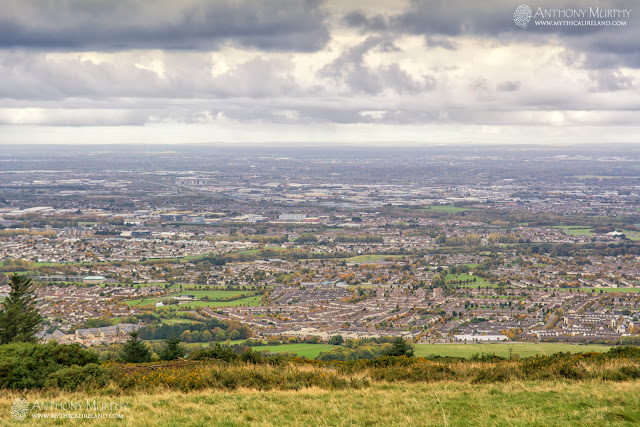 |
| There are fantastic views of Dublin city from Montpelier Hill, where the Hellfire Club dig is located. |
However, the dig, led by Neil Jackman of Abarta Heritage, is significant for other reasons too. Firstly, the dig will help to prove that the monument is, in fact, the remains of a Neolithic passage-tomb. Secondly, and more importantly, if radiocarbon dating is successful, it will be the first time that a monument in the Dublin and Wicklow Mountains cluster of passage-tombs is properly dated. Some of these monuments were excavated in the early 20th century, in pre-carbon dating times.
 |
| Visiting children from a Dublin school find out about the excavation at the Hellfire Club. |
Regrettably, the monument has been much disturbed and partially destroyed. Large amounts of cairn stones were removed for the construction of a building known as the Hellfire Club, which was originally built as a shooting lodge by politician William Connolly, in 1725. Larger stones, including most of the kerb stones and the structural passage and chamber stones, were believed to have been dug out and broken up as foundation material for the laying of the nearby Military Road about 200 years ago. So the passage-tomb at the Hellfire Club, although it was originally reasonably large in size at c.35m diameter, is now just a shadow of its former self.
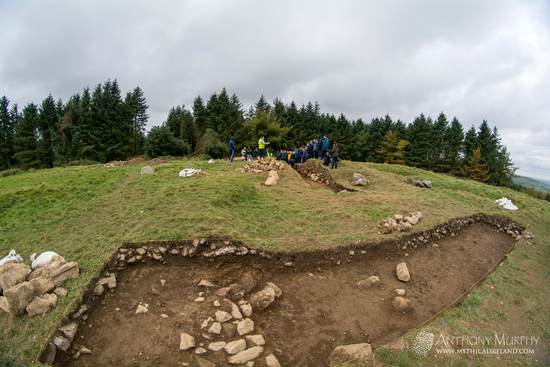 |
| The second trench which was excavated at the Hellfire passage-tomb. |
However, the importance of the archaeological work is that it will help to date the site - and that will be exciting. For instance, archaeologists will want to know if the site perhaps predates the famous Boyne tombs of Newgrange, Knowth and Dowth. Perhaps these mountaintop cairns are as old as those in Loughcrew, Co. Meath, or even those in Co. Sligo.
 |
| The polished stone axe head which was found during the dig, being held by yours truly! |
Very little remains of the internal structure, for reasons outlined above. However, parts of the central area of the cairn have been revealed during the dig, including some layering of turves, and a large stone believed to have been an orthostat, which was not removed two centuries ago, was also uncovered. One nice find was a polished axe head, which I was lucky to have been able to hold in my hand and photograph during the visit. Neil Jackman said the axe head shows no sign of having been used, leading him to speculate that perhaps it was left in the tomb as an offering.
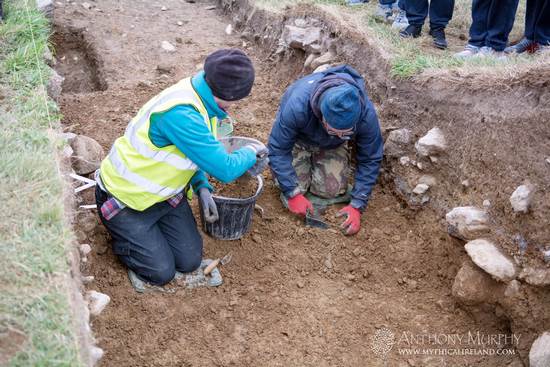 |
| Archaeologists working in one of the trenches of the ruined passage-tomb. |
Another thing that always interests me about passage-tombs is their relationship to other monuments and landscape features. While I was there, I was able to see that there is a grand vista that takes in huge amounts of the ancient landscape. This vista sweeps from the easy, with Fairy Castle on the mountain at Three Rock, across Dublin Bay to ancient Ben Edair, and taking in views in varying degrees of distance of places including the Cooley and Mourne Mountains, the Fourknocks ridge, Hill of Slane, the Hill of Tara, and even, far to the northwest, the ancient cairn-topped hills of Loughcrew in Co. Meath.
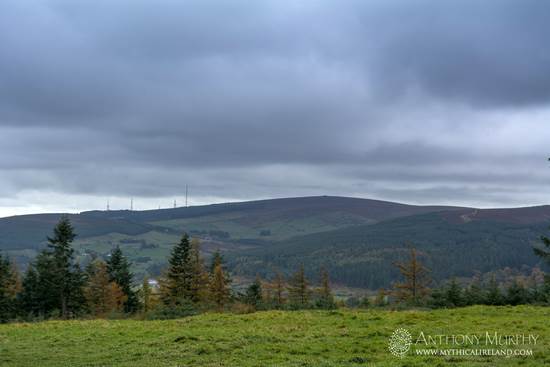 |
| The Fairy Castle passage-tomb in Ballybrack townland, to the east of Montpelier Hill. |
The archaeological dig at the Hellfire Club is finishing this week, after just four weeks of work. It will be interesting to see what carbon dates reveal about the age of the site. In the meantime, if you would like more information about the dig, visit the Abarta Heritage Hellfire Club Archaeological Project website.
Special thanks to Neil Jackman for allowing me to visit the site and take photographs.
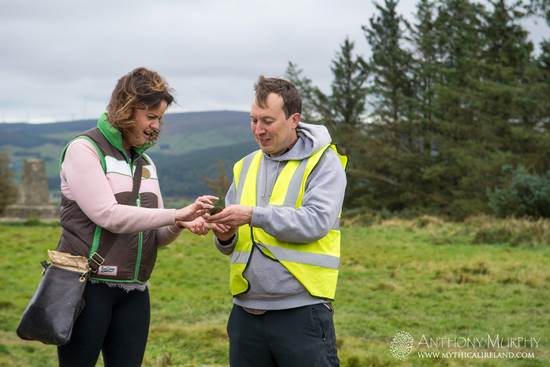 |
| Neil Jackman showing a visiting teacher the polished stone axe head. |
References:
(1) http://www.askaboutireland.ie/aai-files/assets/libraries/south-dublin-county-library/reading-room/Digital%20Books/Glenasmole%20Roads.pdf
Websites:
http://www.abartaheritage.ie/hellfire-club-archaeological-project/
https://www.facebook.com/AbartaHeritage
